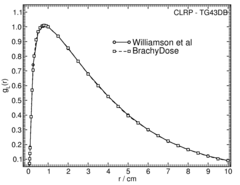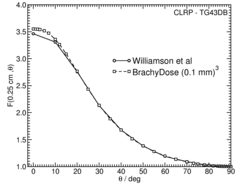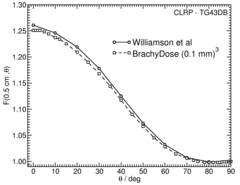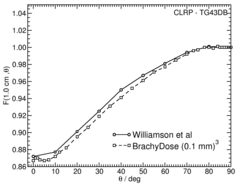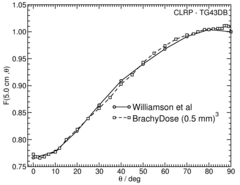

Source Description:
Seed dimensions for the LS-1 seed 1,2,3,4,5 are the same as those used in the study by Williamson. The DRAXIMAGE BrachySeed LS-1 consists of two 0.5mm diameter aluminum silicate spheres containing a uniform distribution of 125 I. Density of the aluminum silicate is 2.81 g/cm 3 and composition by weight is 40.7% oxygen, 21.4% silicon, 16.6% aluminum, 11.3% sodium and 10.0% silver (the amount of 125 I within the spheres is assumed to be negligible). The two source spheres are separated by a 90% Pt / 10% Ir cylindrical rod that is 3.00 mm long and has a diameter of 0.380 mm. At the middle of the seed is a 1.20 mm long Ti annulus with inner and outer diameters of 0.390 mm and 0.698 mm, respectively. The wall thickness of the cylindrical portion of the source is 0.100 mm. The hemi-spherical ends are 0.065 mm thick on the longitudinal axis and 0.050 mm thick where they meet the cylindrical walls. End welds are modelled using a 0.400 mm radius Ti hemisphere overlapped with a 0.350 mm radius air sphere with its center shifted by 0.015 mm relative to the Ti sphere. The overall source length is 4.40 mm and the active length is 4.10 mm. The two spheres are free to move approximately 0.050 mm along the seed axis and 0.050 mm radially.Dose Rate Constant - Λ :
Dose rate constants, Λ , are calculated by dividing the dose to water per history in a (0.1 mm) 3 voxel centered on the reference position, (1 cm,Π/2), in the 30x30x30 cm 3 water phantom, by the air kerma strength per history (scored in vacuo ). As described in ref. 6 , dose rate constants are provided for air kerma strenth calculated using voxels of 2.7x2.7x0.05 cm 3 (WAFAC) and 0.1x0.1x0.05 cm 3 (point) located 10 cm from the source. The larger voxel size averages the air kerma per history over a region covering roughly the same solid angle subtended by the primary collimator of the WAFAC 7,8 at NIST used for calibrating low-energy brachytherapy sources and is likely the most clinically relevant value. The small voxel serves to estimate the air kerma per history at a point on the transverse axis.
| Author | Method | Λ (cGy h-1 U-1) | Abs. Uncertainty |
| R. E. P. Taylor, D. W. O. Rogers 9 | WAFAC | 0.922 | 0.002 |
| R. E. P. Taylor, D. W. O. Rogers 9 | point | 0.922 | 0.005 |
| J. F. Williamson 1 | WAFAC (PTRAN) | 0.935 | 0.017 |
| R. Wang, R. Sloboda 2 | point (EGS4) | 0.932 | 0.003 |
| R. Nath, N. Yue 5 | TLD | 1.02 | 0.07 |
| G. Chan, W. V. Prestwich 3 | GaF Chromic film | 0.98 | 0.06 |
| G. Chan, W. V. Prestwich 3 | extrap (CYLTRAN) | 0.90 | 0.03 |
| M. J. Rivard et al 10 | Consensus value | 0.972 |
Radial dose function - g(r):
The radial dose function, g(r), is calculated using both line and point source geometry functions and tabulated at 36 different radial distances ranging from 0.05 cm to 10 cm. Fit parameters for a modified polynomial expression are also provided 11 .
| Fitting coefficients for g L (r) = (a 0 r -2 + a 1 r -1 +a 2 + a 3 r +a 4 r 2 + a 5 r 3 ) e -a 6 r | ||||||||
| Fit range | Coefficients | |||||||
| r min (cm) | r max (cm) | a 0 / cm 2 | a 1 / cm | a 2 | a 3 / cm -1 | a 4 / cm -2 | a 5 / cm -3 | a 6 / cm -1 |
| 0.20 | 10.00 | -8.2908E-04 | -1.5007E-01 | 1.3099E+00 | 3.7178E-01 | 9.0981E-03 | 7.9701E-04 | 4.3220E-01 |
Anisotropy function - F(r,θ):
Anisotropy functions are calculated using the line source approximation and tabulated at radii of 0.1, 0.15, 0.25, 0.5, 0.75, 1, 2, 3, 4, 5, 7.5 and 10 cm and 32 unique polar angles with a minimum resolution of 5 o . The anisotropy factor, φ an (r), was calculated by integrating the solid angle weighted dose rate over 0 o ≤ ϑ ≤ 90 o .
References:
1. J. F. Williamson, Dosimetric characteristics of the DRAXIMAGE model LS-1 interstitial brachytherapy source design: A Monte Carlo investigation, Med. Phys., 29 , 509 -- 521, 2002
2. R. Wang, R. Sloboda, Monte Carlo dose parameters of the BrachySeed model LS-1 125 I brachytherapy source, Appl. Radiat. Isotopes, 56 , 805--813, 2002
3. G. Chan, W. V. Prestwich, Dosimetric properties of the new 125 I BrachySeed model LS-1 source, Med. Phys., 29 , 190--200, 2002
4 error: unknown reference. Correct info file or add to references.dat
5. R. Nath, N. Yue, Experimental determination of a newly designed encapsulated interstitial brachytherapy source of iodine-125-model LS-1 BrachySeed, Appl. Radiat. Isotopes, 55 , 813--821, 2001
6. R. E. P. Taylor et al , Benchmarking BrachyDose: voxel-based EGSnrc Monte Carlo calculations of TG--43 dosimetry parameters, Med. Phys., 34 , 445 -- 457, 2007
7. R. Loevinger, Wide-angle free-air chamber for calibration of low--energy brachytherapy sources, Med. Phys., 20 , 907, 1993
8. S. M Seltzer et al , New National Air-Kerma-Strength Standards for 125 I and 103 Pd Brachytherapy Seeds, J. Res. Natl. Inst. Stand. Technol., 108 , 337 -- 358, 2003
9. R. E. P. Taylor, D. W. O. Rogers, An EGSnrc Monte Carlo-calculated database of TG-43 parameters, Med. Phys., 35 , 4228--4241, 2008
10. M. J. Rivard et al , Supplement to the 2004 update of the AAPM Task Group No. 43 Report, Med. Phys., 34 , 2187 -- 2205, 2007
11. R. E. P. Taylor, D. W. O. Rogers, More accurate fitting of 125 I and 103 Pd radial dose functions, Med. Phys., 35 , 4242--4250, 2008
Carleton Laboratory for Radiotherapy Physics
December 17 2007.
